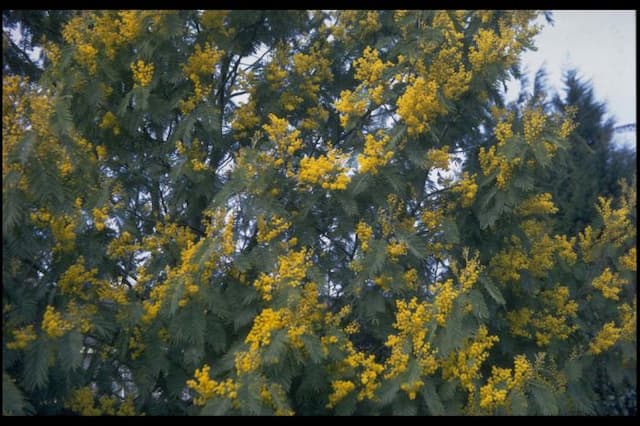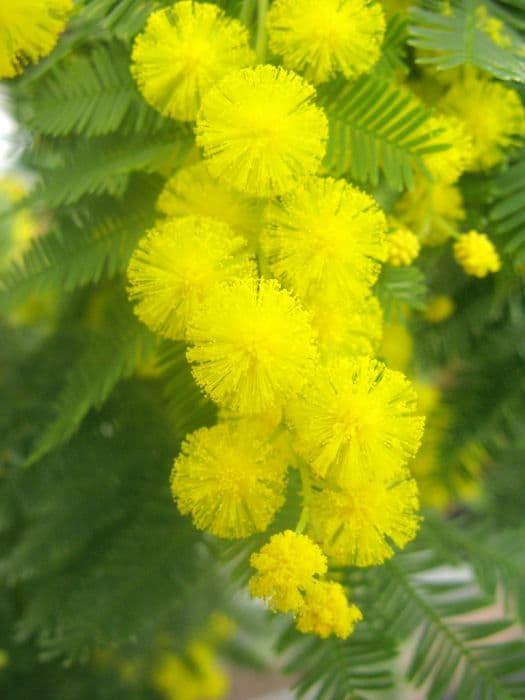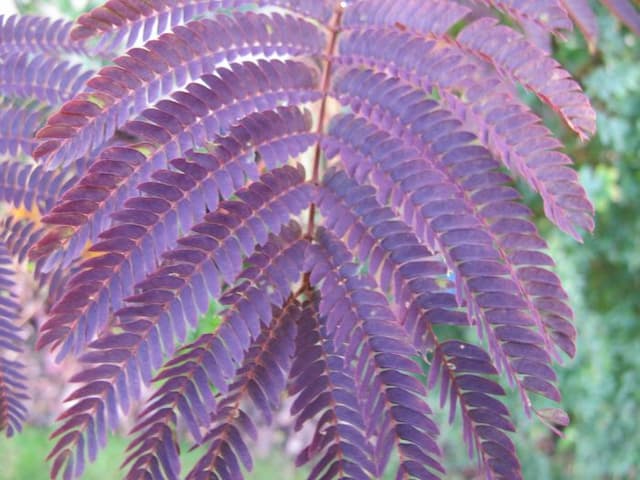Sweet pea Lathyrus odoratus 'Windsor'

ABOUT
Sweet pea 'Windsor' is a flowering plant celebrated for its enchanting fragrance and striking blossom beauty. It showcases elegant, ruffled blooms that come in a deep, maroon hue, which can almost appear to be a velvety chocolate or deep burgundy color under certain light. The flowers possess a delicate charm with their butterfly-like shape, comprising each bloom with an intricate structure of a standard petal at the back, wing petals on the sides, and a keel in front. The sweet pea's petals are soft and almost translucent with the veins sometimes visible, adding to the visual allure. Each blossom grows on a long slender stem, typically surrounded by a few lance-shaped, light green leaves. These leaves are small and often grow in pairs, providing a subtle backdrop that complements the striking blooms. The plant itself has an overall bushy and lush appearance, displaying an abundant flowering habit that creates clusters of these magnificent blooms throughout the blooming season. The sweet pea 'Windsor' is a popular choice among gardeners not only for its visual appeal but also for the rich, sweet scent emanating from the flowers. This makes it an excellent addition for gardeners wanting to create an area of olfactory delight in their gardens or for cutting gardens, from which bouquets can be picked to spread the fragrance indoors.
About this plant
 Names
NamesSynonyms
Sweet Pea, Everlasting Pea, Perennial Pea.
Common names
Lathyrus odoratus 'Windsor'.
 Toxicity
ToxicityTo humans
Sweet pea, particularly the seeds, can be toxic if ingested in large quantities due to the presence of a compound called beta-aminopropionitrile that can cause a condition known as lathyrism. This condition can result in paralysis, labored breathing, convulsions, and even death. Symptoms from less severe poisoning can include vomiting, stomach pain, and headache.
To pets
Sweet pea is also toxic to pets, with similar potential effects as in humans. Ingesting the seeds or plant material can lead to lathyrism, a condition that can cause weakness, tremors, seizures, paralysis, and potentially fatal respiratory issues. It's important to prevent pets from consuming any part of the plant. Symptoms of mild poisoning might manifest as vomiting or diarrhea.
 Characteristics
CharacteristicsLife cycle
Annuals
Foliage type
Deciduous
Color of leaves
Green
Flower color
Maroon
Height
6 feet (1.8 meters)
Spread
1 foot (0.3 meters)
Plant type
Climber
Hardiness zones
2
Native area
Mediterranean
Benefits
 General Benefits
General Benefits- Aesthetic Appeal: Adds vibrant color and visual interest to gardens and landscapes.
- Attracts Pollinators: Entices bees, butterflies, and other beneficial insects, promoting biodiversity.
- Fragrance: Emits a pleasant scent which enhances the sensory experience of a garden.
- Cut Flowers: Suitable for bouquets and floral arrangements with its long stems and attractive blooms.
- Privacy Screening: Can be used to create natural privacy screens when grown on trellises or fences.
- Ease of Cultivation: The Sweet Pea is relatively easy to grow, making it suitable for gardeners of all skill levels.
- Edible Flowers: Blossoms may be used to decorate or add subtle flavor to dishes, though other parts of the plant are toxic if ingested.
- Seasonal Interest: Typically blooms in the late spring and early summer, filling the seasonal gap between spring bulbs and summer perennials.
- Variety: Offers a range of colors, providing options for different garden color schemes.
- Companion Planting: Can be beneficial when planted with a variety of other plants to create a diverse and healthy ecosystem.
- Climbing Habit: Its ability to climb allows for vertical gardening, saving space and adding dimension to garden displays.
 Medical Properties
Medical PropertiesThis plant is not used for medical purposes.
 Air-purifying Qualities
Air-purifying QualitiesThis plant is not specifically known for air purifying qualities.
 Other Uses
Other Uses- Sweet pea 'Windsor' vines can be used to create natural screens or dividers in garden spaces by training them to grow along fences or trellises.
- The dried stems and pods of sweet peas can be used in crafting and decoration, offering a rustic and natural look to floral arrangements.
- Educational tools in botany classes for studying pollination, as the structure of sweet pea flowers is ideal for demonstrating the process.
- In art, sweet pea flowers are often used as subjects for botanical illustration and watercolor painting, providing inspiration with their vibrant colors.
- As a colorant, the flowers of sweet peas, particularly the deep purple hues of 'Windsor', can be used to dye fabrics or paper naturally.
- Sweet pea flowers are used in perfumery for creating floral scents, even though 'Windsor' may not be used commercially, its fragrance can inspire homemade perfumes.
- The petals of sweet pea flowers can be used in papermaking, creating decorative and fragrant handmade papers.
- For photography, sweet peas provide an attractive and colorful backdrop or subject matter for garden photography and macro shots.
- In culinary, while not widely consumed, the flowers can be used as edible decorations on salads and desserts, assuming they are free from pesticides.
- Insects such as butterflies and bees are attracted to sweet peas, thus planting 'Windsor' can support local pollinator populations.
Interesting Facts
 Feng Shui
Feng ShuiSweet pea is not used in Feng Shui practice.
 Zodiac Sign Compitability
Zodiac Sign CompitabilitySweet pea is not used in astrology practice.
 Plant Symbolism
Plant Symbolism- Blissful Pleasure: Sweet peas, including Lathyrus odoratus 'Windsor', are often associated with blissful pleasure due to their enchanting fragrance and delicate blossoms.
- Goodbye or Departure: In the language of flowers, sweet peas can signify bidding farewell or saying goodbye, making them suitable for someone embarking on a journey or leaving.
- Thankfulness: Sweet peas are a common way to express gratitude for a lovely time, hence they are often used to convey thanks.
- Delicate Pleasures: The sweet pea's graceful appearance embodies the idea of delicate or simple pleasures in life.
- Adieu: The association with farewells or goodbyes also carries the simpler sentiment of "adieu," adding a touch of elegance to parting.
 Water
WaterSweet Peas require thorough watering, especially during dry spells. They prefer a consistent moisture level, so watering once a week with one to two gallons of water per plant is ideal. During particularly hot or windy weather, you may need to water more frequently. Ensure the water reaches deep into the soil to encourage deep root growth. Avoid overhead watering to prevent disease, instead use a soaker hose or water at the base of the plants.
 Light
LightSweet Peas thrive in full sun with at least six hours of direct sunlight each day. They can tolerate partial shade, but flowering may be reduced. The best spot for them is away from shade-casting trees and structures to ensure they receive abundant sunlight throughout the day.
 Temperature
TemperatureSweet Peas grow best in cooler temperatures and can be damaged by high heat. They prefer daytime temperatures between 55°F and 65°F and can tolerate nighttime temperatures down to 40°F. They should be protected from frost, and in areas with hot summers, planting them where they can get afternoon shade can help extend blooming.
 Pruning
PruningPruning Sweet Peas is essential to promote vigorous growth and abundant blooms. Pinch out the tips of young plants to encourage bushiness. Regularly deadhead spent flowers to encourage continuous blooming. After the first flush of flowers, cut the plants back by about half to stimulate a second wave of blooms.
 Cleaning
CleaningAs needed
 Soil
SoilSweet Pea 'Windsor' thrives best in rich, well-draining soil with an addition of compost or well-rotted manure. The ideal soil pH for Sweet Peas is between 6.0 and 7.5, slightly acidic to neutral. A mixture of garden soil, peat moss, and perlite in equal parts creates an ideal growing medium.
 Repotting
RepottingSweet Peas, including the 'Windsor' variety, are typically sown directly where they are to flower and are not commonly repotted. If started in containers, they should be transplanted to the garden before they become root-bound.
 Humidity & Misting
Humidity & MistingSweet Pea 'Windsor' prefers moderate humidity levels but is adaptable to a range of conditions. It is important to ensure good air circulation to prevent disease, especially in humid climates.
 Suitable locations
Suitable locationsIndoor
Grow Sweet Peas indoors in bright, indirect light; ensure good air flow.
Outdoor
Plant Sweet Peas in sunny spot, provide trellis for support, and water regularly.
Hardiness zone
2-11 USDA
 Life cycle
Life cycleSweet pea 'Windsor' begins its life as a hard seed that requires soaking or scratching before sowing to ensure germination. After planting, the seed germinates, usually within 1-3 weeks, developing into a seedling with a pair of true leaves following the initial emergence of cotyledons. The plant then enters a vigorous vegetative growth stage where it develops a climbing stem and compound leaves that are adept at grasping support structures. During the flowering stage, Sweet pea 'Windsor' produces fragrant, colorful blossoms, typically in the late spring or early summer, which are pollinated by insects, mainly bees. If pollination is successful, the plant produces pods containing several seeds, completing its reproductive cycle. After seed set, the plant begins to lose vigor, with annual varieties dying off after seed maturation, and in perennial varieties, the plant may go into dormancy until the next growing season.
 Propogation
PropogationPropogation time
Spring to early summer
The most popular method of propagating Sweet Pea 'Windsor' is by sowing seeds. The best time to sow Sweet Pea seeds is either in late October to November or from January to April, with the cooler months providing an ideal climate for germination, though this can depend on the local climate zone. To propagate, seeds should be soaked in water for 24 hours to soften the hard outer shell. Afterwards, planting the seeds in small pots about 1 inch deep in soil and spacing them around 2 inches apart allows sufficient room for initial growth. These pots can be placed in a cool, bright place, but not in direct sunlight, as Sweet Peas prefer cooler temperatures for germination. Seedlings typically emerge in 10 to 14 days and can be transplanted into the garden once they are sturdy enough and frost risk has passed.









